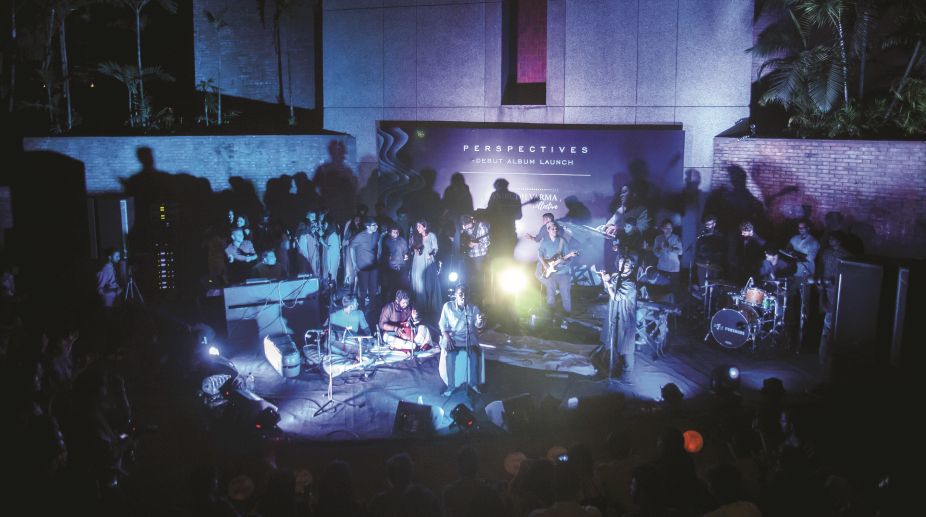A celebration of India’s classical dance heritage at Samasrava
The capital city witnessed an enchanting evening of classical dance at Samasrava, organised by Manasija, a non-profit dedicated to promoting Indian art and culture, recently.
Popular compositions rendered with a contemporary perspective marked the Anirudh Varma Collective, a collaborative project bringing artists and musicians of diverse musical and cultural backgrounds together. A review by Manjari Sinha

The overflowing Amphitheatre of the India Habitat Centre, was mostly filled with a young audience agog with anticipation, when the Anirudh Varma Collective presented Perspectives, a live concert for the launch of their debut album of the same title.
The main cause for this compulsive curiosity that heralded such large crowds, was the remarkable feature of this unique album, where the Hindustani Ragas and their popular compositions were rendered with a contemporary perspective, enhanced with a sort of fusion music.
Advertisement
Anirudh Varma is a gifted young pianist, contemporary musician and composer, trained in both Western and Hindustani classical music. Born in a musical family from Allahabad, Anirudh has music in his genes.
Advertisement
He started training in keyboards at the age of six and later learnt Pianoforte under Lothunglo Mozhui and the late Hosie Palamkote, the ex-principal of Delhi School of Music.
Anirudh has also been trained in Hindustani classical music under Manas Majumdar. In the past, he has played with the ensemble, The House of Symphony, and with bands like Raag-Leela, Plok, Cobbled Street, Steller Teller, Pakshee and Nuur. At present, he is playing with fusion ensemble Sab-Culture.
Since he loves both Western and Indian classical music, Anirudh was concerned about the aversion of the younger generation towards Indian classical music and wanted to do something about popularising it among the younger audience.
Given his exposure to diverse musical influences, he often perceived Hindustani classical music through a Western classical lens. He had already released his debut EP Melancholic Rhapsody in early 2016 that combined the influences of Western classical, contemporary Jazz and Indian classical music.
The popularity of this album on platforms such as iTunes, Apple Music, Amazon Music and Google Music encouraged him to try the initiative of a group collective.
The Anirudh Varma Collective is a collaborative project, bringing artists and musicians of diverse musical and cultural backgrounds together to form a unique musical identity.
The idea behind this venture was also to showcase Anirudh’s identity as a composer, producer and music director, incorporating the energy and perspectives of the musicians, who are featured on his compositions and repertoire. The Anirudh Varma Collective is, in fact, an attempt to showcase the eclectic hues and innumerable facets of the contemporary Indian Art scenario.
With an incredible blend of over 50 musicians from the contemporary Indian music industry, with diverse musical backgrounds, bringing in their own colour and identity, this musical evening (and, of course, the released album) Perspectives, was a contemporary representation of Hindustani classical music, for both, the musician and the audience community.
The opening piece La Maree emerged from the nimble finger tips of Anirudh on Keys, as a glimpse of his musical journey from his first album Melancholic Rhapsody to Perspectives.
The sombre melody that sounded like an Organ being played in some far away church came closer to the Swaras of Jhinjhoti and the chorus of male and female voices took up the clue for singing “Sanvariya ne…”, part of the Mukhda of Ratanjankar’s famous composition “Mero mann sakhi har lino Sanvariya ne…”, bringing in the “colours” of Jhinjhoti.
The pause after the Sthayi brought again the Western inputs by Anirudh, before Saptak Chatterjee started “Sagun bicharo dheer Bamhanavan, kab aayenge more Piya”, ending with a scintillating Taan. The juxtaposed counterpoints and harmonics of the Western music, added myriad hues to the “Colours of Jhinjhoti” in most interesting ways.
The popular composition of Shuddha Kalyan “Ras begi begi aa…Sajan aaye more mandirawa…” had an innocent naivety with the unsure chorus voices. Ujjwal Nagar sang a Dadra of Shobha Gurtu, “Najariya lage nahin kahin aur…”, fully at ease with the rhythm on the Drums and wamping on the Guitars.
The famous Tilak Kamod composition of Bhai ji “Koyaliya bole ambua ki dalariya…” and the other Bandish in the same raga “Neer Bharan Kaise jaun Sakhi ri aaj…”, interestingly altered between male and female voices, added flavour by the Western tinge of Major chords.
Pt Sarathi Chatterjee sang the Maru Bihag and Champakali compositions accompanied by Ahsan Ali on Sarangi and Aniruddh on Keys, interspersed with the Sargams by the chorus group. Then came the composition in Alhaiya Bilawal.
The concluding track of raga Shankara with the Shiva Stuti “Shankar Damru baje…”, sung in the seasoned melodious voice of Prateek Narsimha, took the concert to its climax. The intensity and penetration of his assertive rendering adorned with multi-hued Taans was combined with the vigour of Western and Indian instrumentalists joining together with full enthusiasm.
The thundering applause was followed by the Album launch; celebrated with an impromptu vocal recital by Pt Bhuvanesh Komkali, who was present there as a family friend to the Varma family for three generations, where his grandfather Pt Kumar Gandharva performed innumerous intimate mehfils at their home in Allahabad, whenever he visited the holy city.
Advertisement